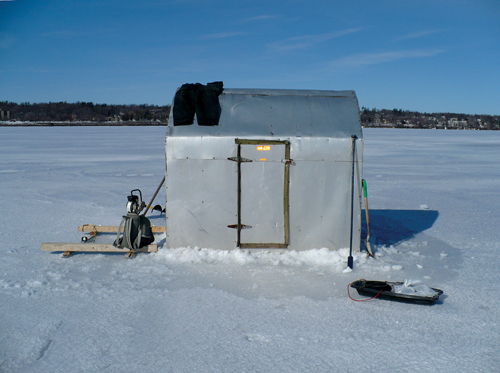small things: ice fishing huts
 Paul Whelan. Ice Fishing Hut on Lake Simcoe, 2008.
Paul Whelan. Ice Fishing Hut on Lake Simcoe, 2008.
Both Steve Sopinka and Paul Whelan wrote, in different articles, about ice fishing huts in Ontario for On Site 21: weather. The Globe & Mail had a piece on them last weekend, and Rob Kovitz has released his long in the making book, Ice Fishing in Gimli. a novel. Kovitz's book is huge, complex and about Gimli, and winter, and Canada, and takes its name from a study Kovitz did about 10 years ago of the ice fishing huts on Lake Winnipeg.
Beautifully crafted little pieces of architecture housing one or two people who spend long days in them with a fishing line dropped through a hole in the ice, ice fishing huts are on their way to being one of the enduring and iconic images of the Canadian winter.
Although a highly individual activity, the collective of huts form a community of sorts, with unwritten rules and oral traditions. They represent a culture that is local, historic, spatially precise, half-sport, half-social with an architecture that has developed from it. Perhaps one can buy a little garden shed from Rona or Canadian Tire and adapt it to sitting on the ice, but Sopinka's and Whelan's research indicate that this is not really what happens. These huts are handmade with considerable care and attention.
Vernacular architecture is a form of building limited by the scope and scale of the individual builder, working with ordinary tools and found materials: things are put together in ways that make professionals both blanch and wonder why their education battered the impulse to make things out of them.
Ice fishing huts are small, the tradition is long, the lake is huge.
